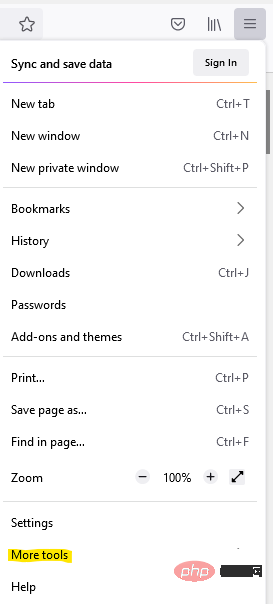
Sometimes when checking Task Manager, you may notice that the Firefox browser is using too much memory or CPU resources. This is because browsers may sometimes require more system resources to download content from the web, process it and then present it to the user. This also happens when you have too many tabs open in the Firefox browser when you want to multitask, for example, checking emails while working or playing games and listening to music, etc.
It could also be that you are loading heavy website content or there are processes running in the background. While Firefox is known for super-safe browsing and many advanced features like customization options or tab management, the fact that it consumes a lot of PC resources can ultimately slow down your PC's performance. The more you use your browser, the more available memory (RAM) it consumes, and the worst part is, this isn't a one-time situation.
Luckily, there are several ways to help you free up RAM and CPU space and ensure your PC runs well while you're using your browser. Here, we've listed some troubleshooting options that can help you resolve issues when Firefox uses too much memory or CPU resources.
Sometimes, updating your browser to the latest version can help get rid of high CPU usage issues. Let’s see how to update Firefox to the latest version:
Step 1: Launch the Firefox browser and navigate to the upper right corner of the window.
Click on the three parallel lines (to open the application menu), then click on Settings.

Step 2: In the Settings window, make sure you are on the General page.
Now, go to the right, scroll down and under the Firefox Updates section, click Check for updates.

Wait for it to finish checking for updates. If there are any updates available, it will automatically install the latest version and display a success message.
Now, restart the browser and you can now check if the CPU usage is still high.
Restarting Firefox regularly can sometimes help solve many problems, including high browser memory or CPU usage. In fact, you can set up Firefox in a way so that the next time you launch the browser, you can pick up where you left off with your saved tabs and windows. This is one of the ways to restart Firefox browser. Let’s see how:
Step 1:Open Firefox and go to the upper right corner.
Click on the three horizontal lines and select History from the menu

Now, click on Restore the previous session.

While this will take you back to the tabs and windows you were working on previously, you can also restart Firefox after the update while you are in Troubleshooting Mode/Safe When you restart Firefox in Windows mode, or when you resume a session by clicking the Resume Session button in the prompt that appears after a Firefox crash.
Step 1: Go to Start and right-click on it.
SelectTask Manager from the menu.

Step 2: In the Task Manager window, under the Processes tab, go to tabpart.
Now, right-click on Firefox and select End task.

After Firefox closes, you can close Task Manager and open Firefox again.
Before proceeding to disable any extensions or themes in the Firefox browser, make sure to first check if the issue is caused by extensions and themes . To do this, you need to launch your browser in safe mode. That's it:
Step one: Open Firefox and enter the three parallel lines in the upper right corner.
Click on it and select Help from the menu.

Now, select Troubleshooting mode.

Step 2: Next, restart Firefox in troubleshooting mode? Tip, click Restart.

Step 3: You will now see a prompt - Open Firefox in Troubleshooting Mode?
Click to open .
Step 4: This will restart the Firefox browser in Troubleshooting Mode/Safe Mode and disable extensions and themes.
Now, if the CPU or memory usage issue is resolved, then the problem is indeed caused by the extension and theme. Therefore, you must disable them immediately. That's it:
*Note - However, if memory and CPU usage are still high, then the problem is not due to extensions and themes.
Step 1: Open Firefox and click the Open Application menu (three parallel lines) in the upper right corner of the browser.
Select Settings from the menu.
Step 2: In the Settings window, at the bottom on the left side of the pane, click the Extensions and Themes option.

Step 3: The Add-in Manager window will now open in a new tab.
Here, click Extensions on the left.
Step 4: Now, navigate to the right and under the “Manage Extensions” section, go to Add-ons.
To disable the plugin, simply slide the toggle to the left.
Step 5: Repeat this for all add-ons.

Now, close the Settings window, restart the browser, and now your Firefox should not be using up too many system resources.
Step 1: Launch the Mozilla Firefox browser, go to the three parallel lines in the upper right corner, click on it and select Settings.
Step 2: In the Settings window, go to the bottom left of the window and click Extensions and Themes.
Step 3: Next, go to the right side and under the “Enabled” section, click on the “Enable” button to disable the theme.
This will automatically apply the default theme and should resolve high CPU and memory usage issues.
Using this method, you can block web content that uses your system resources and you don’t want to see. To do this, you can adjust the Enhanced Tracking Protection feature to help save resources by blocking 3rd party tracker intrusions. Let's see how to adjust the functionality:
Step one: Open Firefox, click on the open application menu (three horizontal lines) in the upper right corner, and select Settings.
Step 2: In the Settings window, click Privacy & Security on the left side of the pane.
Step 3: Now, go to the right side and under the Enhanced Tracking Protection section, select Protection Level - Standard (Balanced Protection and Performance.
to , Strict (Stronger Protection) or Custom (allows you to choose which trackers and scripts to block.)

Now that you have blocked 3rd party tracking content, the browser should not use high system resources.
Step 1: Launch Mozilla Firefox, go to the upper right corner of the browser, and click the three parallel lines.
SelectSettings from the menu.
Step 2: In the Settings window, stay on "General" page.
Now, go to the right and keep scrolling until you reach the "Performance" section.
Step 3: Uncheck Use recommended performance Set the box next to .
Step 4: Next, also uncheck the "Use hardware acceleration when available" option.

The issue with Firefox using too much memory or CPU resources should now be fixed.
*Note – You can also adjust the Content Process Limit field. When using a large number of options at once Choosing a higher number will improve browser performance when stuck and using system memory. If memory issues arise, such as in this case, you can lower the limit below 8.
Mozilla Firefox stores individual website settings in a file in your user profile folder. This file that holds the data can become corrupted and cause high memory and CPU usage issues . Therefore, deleting or renaming this file can help solve CPU usage issues. Let’s see how:
Step 1: Open Firefox, navigate to the three horizontal lines in the upper right corner, and click to open the menu.
In the menu, select Help.

Now, click More Troubleshooting Information.

Step 2: It will open the Troubleshooting Information tab in the browser.
Here, go to the Application Basics section and under Profile Folder and click the Open Folder button next to it.

3rd Step: This will open your profile folder in a File Explorer window.
Here, look for the content-prefs.sqlite file, select it and click Delete.
Now, Restart Firefox Browser

*Note –Next time you launch Firefox Browser , a new content-prefs.sqlite file will be created again.
Now, Firefox’s high memory and CPU usage issues should be resolved.
By refreshing the browser, your Firefox profile will be restored to its original state, which can help solve the problem. Let's see how to refresh Firefox:
Step 1: Open Mozilla Firefox, go to the three parallel lines in the upper right corner, click on it and select Help from the menu.

Step 2: Next, click on the More Troubleshooting Information option.

Step 3: In the Troubleshooting Information tab that opens, go to the right and under Tweak Firefox, click Refresh Firefox".

More Tools in the menu

Task Manager .


about:memory in the address bar and press Enter.
Step 2: You will now see a list of options. Click the "Minimize memory usage" button below the "Available Memory" option.

About: Configuration
Step 2: In the next window, under the "Caution Caution" warning, click the "Accept the Risk and Continue" button to continue. Step 3: Next, in the Search Preferences Name search bar, type the following address:browser.sessionhistory.max_entries
You You will now see the results below. Click thepencil icon to its right to edit the field.
Change the number to a smaller number and press the blue tick to the right of it to save the changes.
While restarting your PC is the first trick you can try and works in most cases, you can also choose to use fewer tabs and reduce the load on system memory usage.
Another wise move is to close many open applications to see if this helps reduce memory and CPU usage. Alternatively, you can also check how your system resources are performing under the Performance tab of the Task Manager window.
Despite all the above solutions, if your system is still low on memory, adding new RAM can help improve system performance. However, if nothing works, upgrading your computer may be the only option.
The above is the detailed content of How to Easily Fix Firefox High CPU Usage Issues. For more information, please follow other related articles on the PHP Chinese website!




